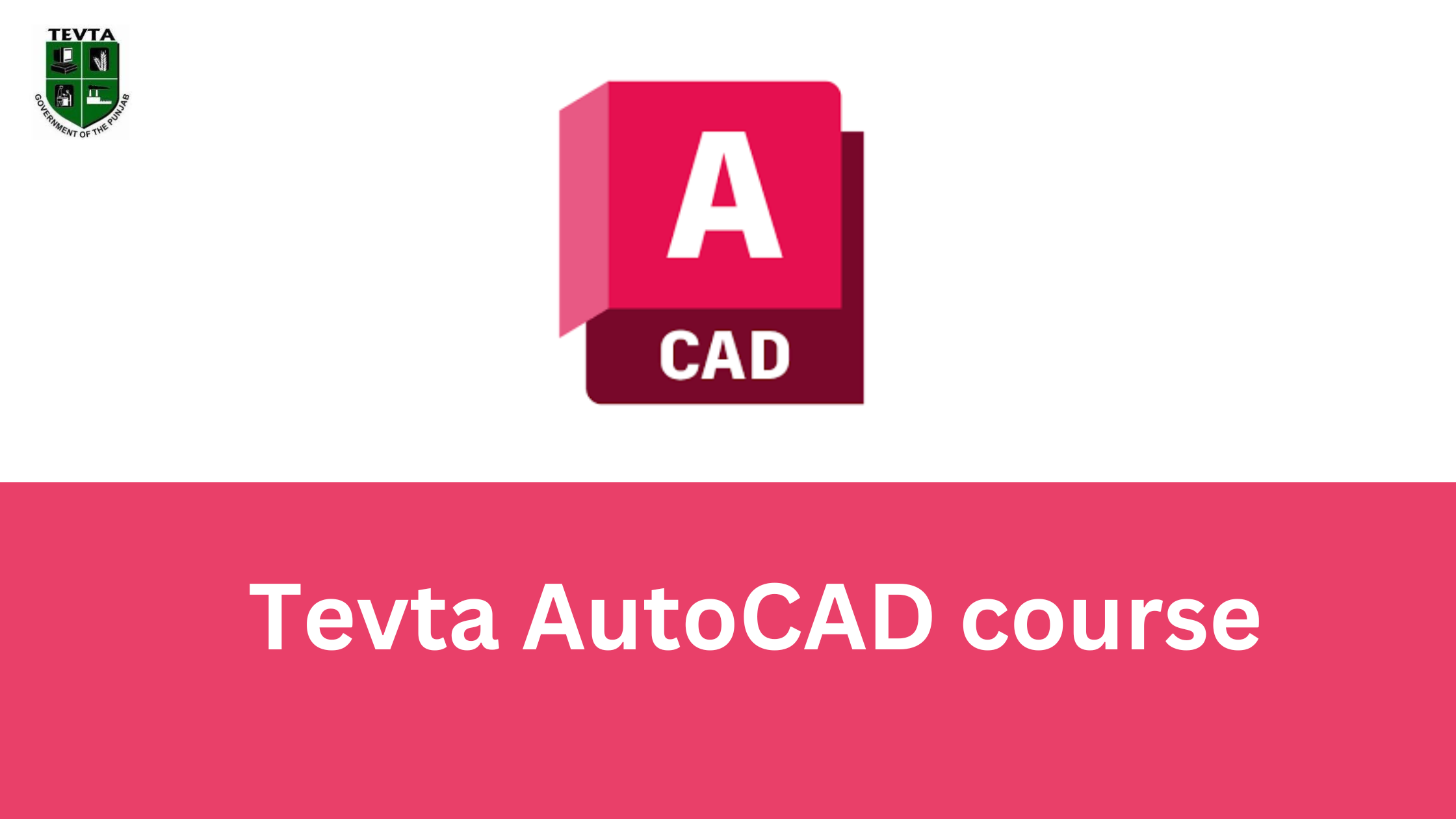Tevta AutoCAD course
Tevta AutoCAD course is the best option in 2025 because computer-aided drafting has replaced manual drafting in the construction industry. Manual drawing, which requires expensive printing/drawing equipment, has become much easier and more interesting with computer-aided drawing/drafting.
There is an urgent need to develop courses equipped with powerful learning and designing tools such as computers keeping in mind the requirements of the new era. AutoCAD beginner course online aims to develop a workforce to meet the current and future demands of the construction industry by introducing computer-aided drafting.
This demand-driven Tevta AutoCAD course aims to improve the quality of classroom delivery and The trained persons are to be equipped with the latest computer-aided designing/drafting techniques. AutoCAD course scope is very bright if you want to know more about this course read the details below.
Also see: Advanced Diploma in Land Resource Survey & GIS (6-Month Course)
Details About Tevta AutoCAD course
- Entry Level: Matric
- Total Duration of Course: 6 Months
- Total Contact Hours: 800 Contact Hours
- Training Methodology: Practical 80%, Theory 20%
- Medium of Instruction: Urdu/English
SKILL PROFICIENCY DETAILS
On successful completion of the Tevta AutoCAD course in Lahore, a trainee will be able to:
- Prepare detailed drawings for housing units using manual drafting techniques.
- Operate AutoCAD software.
- Create a library of blocks or symbols to use in the drawing and insert them at specific locations with different scales and rotations.
- Create appropriate layers with different colors and types of lines.
- Prepare sets of drawings for residential and commercial buildings for approval and enabling construction.
- Create views of certain parts of the drawing.
- Make perspective views of residential and commercial buildings.
- Prepare detailed drawings of frame structure buildings and engineering works.
KNOWLEDGE PROFICIENCY DETAILS
On successful completion of this Tevta online course, the trainee will be able to:
- Explain health and safety considerations in preparing construction drawings.
- Understand the fundamentals of projections and projection planes.
- Describe the relationship between plans, elevations, and sections.
- Identify the different methods of graphical representation and explain their uses.
- State the basic components of civil engineering structures.
- Explain how and why perspective drawings are made.
- Define basic water supply and drainage service arrangements for buildings and explain the components of service drawings.
- State the advantages of using AutoCAD in preparing construction drawings.
Also see: Telecom Technician (Line & Mobile) (3-Month Course) Curriculum
SCHEME OF STUDIES For Autocad full course
Tevta AutoCAD course in islamabad
- Fundamental of Engineering Drawings: 48 hours (Theory), 120 hours (Practical), Total: 168 hours
- Mensuration: 23 hours (Theory), 33 hours (Practical), Total: 56 hours
- Computer Applications: 20 hours (Theory), 81 hours (Practical), Total: 101 hours
- CAD Basics: 15 hours (Theory), 84 hours (Practical), Total: 99 hours
- Architectural & Structural Drawing (2D): 14 hours (Theory), 123 hours (Practical), Total: 134 hours
- 3D Modeling: 12 hours (Theory), 81 hours (Practical), Total: 93 hours
- Project: 3 hours (Theory), 39 hours (Practical), Total: 42 hours
- Occupational Health and Safety: 12 hours (Theory), 15 hours (Practical), Total: 27 hours
- Functional English.
DETAIL OF COURSE CONTENTS
AutoCAD crash course (6 — Months Course)
- Fundamental of Engineering Drawing 1.1. Introduction
- History of engineering drawing
- Types of drawings
- Drawing tools and instruments
- Drawing sheet 1.2. Lettering and Lines
- Types of lettering
- Single-stroke lettering styles
- Vertical and inclined styles
- Types of lines: Identification and construction
- Selection of pencil
- Title strips and title blocks: types and sizes 1.3. Geometrical Drawing
- Angle and types of angle
- Plane geometrical figures: types & construction, triangles, quadrilateral, and polygons
- Circle: sector & segment
- Geometrical solids: types
- Conical curves: ellipse, parabola, hyperbola, and their application and construction 1.4. Scale
- Types and uses
- Representative fraction
- Graphical representation of scale
- Selection of scale 1.5. Sketching
- Techniques in sketching lines
- Principles of freehand sketching
- Sketching to scale
- Methods of sketching: circle, ellipse, and different geometrical shapes 1.6. Orthographical Projections
- Projections: Parallel projections and central projections
- Principal planes of projection, dihedral angles, and trihedral angles
- 1st Angle Projection System
- 3rd Angle Projection System
- Rules to draw orthographical projections 1.7. Sectioning
- Purpose of sectional view
- Location of cutting plane line: arrowhead
- Types of sectional views: Full section, half section, and auxiliary views 1.8. Dimensioning
- Types of dimensions: dimension lines, symbols, and notes
- Methods of dimensioning: Location dimensioning system, base-line dimensioning system
- Rules and procedures for dimensioning 1.9. Pictorial Drawing
- Definition, uses & types
- Isometric axis, angle & scale
- Method of construction of isometric
- Oblique projections: types & construction
- Perspective projections: vanishing point, parallel & angular perspective 1.10. Engineering Materials
- Bricks & tiles: types
- Concrete: ingredients, types, and usual ratios
- Timber: types, seasoning, and wood products
- Ferrous metals: types, structural steel sections, and reinforcing steel
- Non-ferrous metals: aluminum properties and uses
- Paints, distemper, emulsion: uses
- Stone: types and uses in building construction
- Glass: types & uses 1.11. Building Structures
- Classification of buildings
- Structures: masonry structures, timber structures, frame structures, and composite structures 1.12. Components of Buildings
- Foundations: shallow and deep foundations and functions
- Damp proof course: types & materials
- Masonry work: mortar, bonds
- Walls: types & function
- Arches & lintels: types & function
- Doors & windows: types and function
- Stair & staircase: types of stairs
- Floors: types and composition
- Roofs: types and composition 1.13. Water Supply & Drainage
- Basic requirements for residential buildings
- Types of water supply pipes, fittings, fixtures, and valves
- Sewer pipe: types and jointing
- Sanitary fittings & fixtures
- Septic tank, soakage pit 1.14. Roads and Road Structures
- Road components & road geometry
- Types of bridges and culverts
- Components of bridges and culverts 1.15. Building Drawing
- Common building terms
- Building symbols: materials and components (including sanitary and electrical installation symbols)
- Types of building drawings: submission drawings, working drawings, as-built drawings
- Abbreviations used in building drawing
- Mensuration 2.1. Basic Arithmetic
- Addition, subtraction, multiplication, and division
- Addition, subtraction, multiplication, and division of fractions
- Add, subtract, multiply, and divide decimal numbers
- Percentage: change number to percent, change percent to decimal, and fraction
- Logarithms 2.2. Units, Significant Figures
- Units of measurements
- International System of units
- Ft-lb system
- Conversion of units
- Significant figures
- Rounding off number
- Use of scientific calculator 2.3. Area and Volume
- Area and perimeters of plane geometrical figures
- Areas of irregular shapes: Simpson’s rule, middle ordinate rule, and trapezoidal rules
- Volume and surface area of solid geometrical shapes 2.4. Practical Trigonometry
- Trigonometric ratios
- Trigonometric functions
- Solve right-angle triangles
- Pythagoras’ theorem
- Introduction to coordinate geometry: rectangular coordinates, polar coordinates
- Computer Application 3.1. Introduction to Computer
- Brief history of computers
- Components of computers: hardware, software, input & output devices, storage devices 3.2. Windows Operating System
- Windows interface: icon, taskbar, toolbar, start menu, My Documents, My Computer, recycle bin, Internet Explorer, dialog box
- Setting screen, date, time, & start menu
Tevta AutoCAD course in Rawalpindi Address:
Address: Girja Rd, near Dhoke Syedan Chowk, Rawalpindi, Punjab 46000
Phone: (051) 5684122
Tevta AutoCAD course in Karachi Address:
ST-19, Block 6 Gulshan-e-Iqbal, Karachi, Karachi City, Sindh
Sindh Technical Education & Vocational Training Authority (STEVTA), Karachi, address.
Contact & location : 96-H, GULBERG-II, LAHORE Ph # 042-99263055-9, 99263064 qm.acad@tevta.gop.pk, manager.cur@tevta.gop.pk
People also ask
- How much does an AutoCAD course cost?
Cost varies from PKR 10,000 to 50,000 depending on the institute. - Which AutoCAD certificate is best?
Autodesk Certified Professional (ACP) is widely recognized. - Are AutoCAD courses free?
Yes, some free courses are available on platforms like Coursera, Udemy, and Autodesk. - Is TEVTA a private or government?
TEVTA is a government organization. - What are the eligibility criteria for TEVTA?
Criteria vary by course; generally, matriculation or equivalent is required. - Which AutoCAD course is best?
Autodesk official courses and TEVTA-accredited programs are recommended. - What is AutoCAD fee?
The fee ranges between PKR 10,000 to 50,000 depending on course level. - How to get AutoCAD for free?
Students and educators can get a free educational license from Autodesk. - How much is AutoCAD fee per year?
AutoCAD subscription costs about $1,865 per year (varies by region). - How many days is the AutoCAD course?
Typically, 1 to 3 months. - How to learn AutoCAD quickly?
Focus on basic commands, practice drawings, and use online tutorials. - Is AutoCAD difficult to learn?
It’s easy to learn the basics but requires practice for advanced skills. - Which AutoCAD version is best?
The latest version, like AutoCAD 2025, is generally the best. - What is the maximum salary of AutoCAD?
Salaries can go up to PKR 150,000 per month for experienced professionals. - Who owns AutoCAD?
Autodesk Inc. owns AutoCAD. - Is AutoCAD a profession?
Yes, AutoCAD drafting and design is a well-recognized profession.







